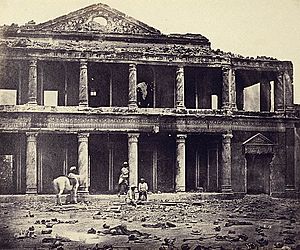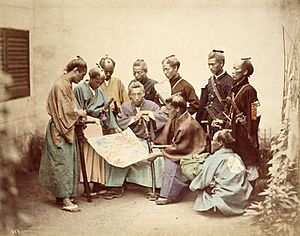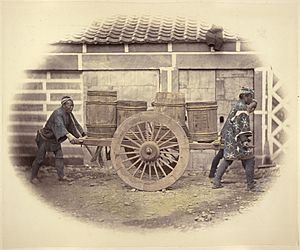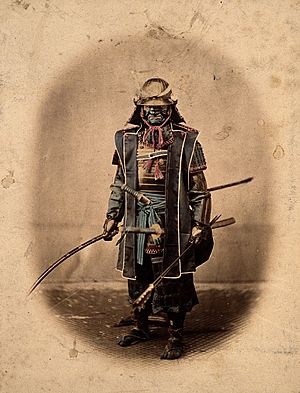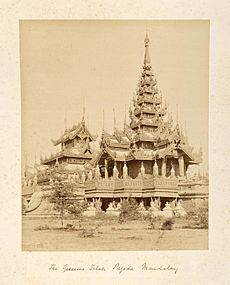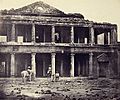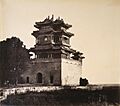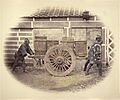Felice Beato facts for kids
Quick facts for kids
Felice Beato
|
|
|---|---|
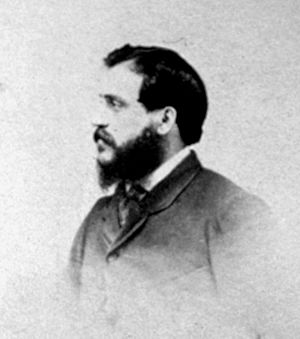
Beato c. 1866
|
|
| Born | 1832 Venice, Kingdom of Lombardy–Venetia
|
| Died | 29 January 1909 (aged c. 76) |
| Nationality | British, Italian |
| Other names | Felix Beato |
| Occupation | Photographer |
| Known for | One of the first people to take photographs in East Asia and one of the first war photographers |
| Relatives | Antonio Beato (brother) |
Felice Beato (born 1832 – died 29 January 1909), also known as Felix Beato, was an Italian-British photographer. He was one of the first people to take pictures in East Asia. He was also one of the very first war photographers.
Beato was known for his photos of people, places, and wide views (called panoramas). He captured buildings and landscapes in Asia and around the Mediterranean. His travels allowed him to photograph countries, people, and events that most people in Europe and North America had never seen. His work includes pictures of the Indian Rebellion of 1857 and the Second Opium War. These photos are some of the earliest examples of photojournalism, which is like news reporting with pictures. Beato inspired many other photographers, especially in Japan, where he taught and worked with many artists.
Contents
Felice Beato's Early Life
We know that Felice Beato was born in Venice in 1832. He died in Florence on January 29, 1909. His death certificate shows he was a British citizen. It is thought that Beato and his family moved to Corfu when he was young. At that time, Corfu was part of a British area called the Ionian Islands. This is likely why he was a British citizen.
For a long time, people thought that "Felice Antonio Beato" was just one photographer. This was because some photos were signed with that name. But in 1983, it was discovered that "Felice Antonio Beato" was actually two brothers: Felice Beato and Antonio Beato. They sometimes worked together and shared a signature. This still makes it tricky to know which brother took certain pictures.
Photographing Wars and Distant Lands
We don't know much about how Felice Beato first learned photography. It's said he bought his only camera lens in Paris in 1851. He probably met British photographer James Robertson in Malta in 1850. Beato then went with Robertson to Constantinople in 1851. Robertson later became Beato's brother-in-law in 1855.
Robertson opened one of the first photo studios in Constantinople between 1854 and 1856. In 1853, Beato and Robertson started taking photos together. They formed a partnership called "Robertson & Beato." Beato's brother, Antonio, joined them on trips to Malta and Jerusalem. Some of their photos from the 1850s are signed "Robertson, Beato and Co." The "and Co." likely meant Antonio.
In 1855, Felice Beato and Robertson traveled to Balaklava, Crimea. They took over photographing the Crimean War after another photographer left. Beato was supposed to be Robertson's helper. But war zones are unpredictable, so Beato had to do more. Unlike earlier war photos that showed the "dignified" side of war, Beato and Robertson showed the destruction and death. They photographed the fall of Sevastopol in September 1855, taking about 60 pictures. Their Crimean photos completely changed how war was shown to the public.
In February 1858, Beato arrived in Calcutta, India. He began traveling across Northern India to photograph what happened after the Indian Rebellion of 1857. During this time, he took what might be the first-ever photos of dead bodies. For one photo at the palace of Sikandar Bagh in Lucknow, it's believed he moved or rearranged the remains of Indian rebels. This was done to make the photo more dramatic. He also visited cities like Delhi, Cawnpore, and Benares. His brother Antonio joined him in July 1858 but left India in December 1859, probably because of his health. Antonio later opened a photo studio in Thebes, Egypt, in 1862.
Documenting China's Second Opium War
In 1860, Beato left his partnership with Robertson. He was sent from India to photograph the British and French military trip to China during the Second Opium War. He arrived in Hong Kong in March and immediately started taking pictures of the city. Beato's photos are some of the earliest ever taken in China.
In Hong Kong, Beato met Charles Wirgman, an artist who worked for the Illustrated London News. They both went with the British and French forces as they traveled north. They visited places like Talien Bay, the Taku Forts, and then Peking and the Summer Palace. Wirgman often used Beato's photos to create his illustrations for the Illustrated London News.
The Taku Forts Battle
Beato's photos of the Second Opium War were the first to show a military campaign as it happened. He did this by taking a series of dated and connected pictures. His photos of the Taku Forts show this method. They tell the story of the battle. The pictures show the approach to the forts, how the outside walls were damaged by bombs, and finally, the destruction inside the forts. This included photos of dead Chinese soldiers. Beato had to take the photos of the dead soldiers first, before the bodies were removed. Only then could he take other pictures of the forts.
A doctor on the trip, David F. Rennie, wrote about Beato. He said Beato was very excited about a group of dead soldiers, calling them "beautiful." Beato asked that they not be moved until he could photograph them.
The Summer Palace
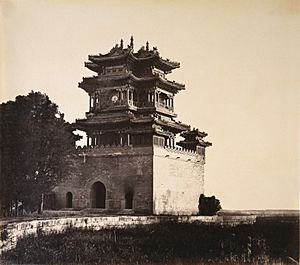
Just outside Peking, Beato took photos at Qingyi Yuan, which is now called Yihe Yuan, the Summer Palace. This was a private estate of the Emperor of China. It had palace buildings, temples, a large man-made lake, and gardens. Some of these photos, taken between October 6 and 18, 1860, are very special. They are the only pictures of these buildings before they were robbed and burned by the British and French forces. On October 18 and 19, the buildings were set on fire by the British. This was ordered by Lord Elgin as punishment for the torture and deaths of some Allied diplomats. These photos are very important for history and culture.
Some of the last photos Beato took in China at this time were portraits. He photographed Lord Elgin, who was in Peking to sign a peace agreement. He also photographed Prince Kung, who signed for the Chinese Emperor.
Beato returned to England in October 1861. That winter, he sold 400 of his photos of India and China to Henry Hering, a photographer in London.
Life and Photography in Japan
By 1863, Beato had moved to Yokohama, Japan. He joined Charles Wirgman, the artist he had met in China. They formed a partnership called "Beato & Wirgman, Artists and Photographers" from 1864 to 1867. This was one of the first and most important photo studios in Japan. Wirgman again made drawings from Beato's photos. Beato also photographed some of Wirgman's artworks.
Beato's Japanese photos include portraits, pictures of daily life, landscapes, and city views. He also took a series of photos along the Tōkaidō Road. This series was like the famous Japanese woodblock prints by Hiroshige and Hokusai. During this time, foreigners were not allowed to travel freely in Japan. But Beato went to many parts of Japan where few Westerners had been. He did this by going with official groups and using his good connections with the British military. Besides pretty subjects, he also photographed shocking things, like heads displayed after beheadings. His pictures are special because they are high quality and rare views of Japan during the Edo period.
Most of Beato's work in Japan was very different from his earlier photos in India and China. In those places, his photos often showed conflict and British power. But in Japan, Beato was eager to photograph Japanese people. He showed them respectfully, even when they seemed to be standing up against the higher status of Westerners.
Beato was very busy in Japan. In 1865, he took many dated photos of Nagasaki and its area. From 1866, he was often made fun of in Japan Punch, a magazine started by Wirgman. In October 1866, a fire destroyed much of Yokohama. Beato lost his studio and many, if not all, of his photo negatives.
Beato was the first photographer in Japan to sell albums of his work. He quickly saw how popular they could be. By about 1870, selling these albums was the main part of his business. Beato probably started the idea of selling photo albums with "views" (landscapes) and "costumes/manners" (people in traditional clothes). By 1868, Beato had two photo albums ready. One was called "Native Types," with 100 portraits and daily life scenes. The other was "Views of Japan," with 98 landscapes and cityscapes.
Many photos in Beato's albums were hand-coloured. In his studio, skilled Japanese watercolor artists and woodblock printmakers added color to his photos.
Around 1869, Beato tried to stop being a photographer. He tried other businesses and let others in his studio do the photo work. His studio was called "F. Beato & Co., Photographers." He ran it with an assistant and several Japanese photographers and artists. Kusakabe Kimbei was likely one of Beato's artist helpers before he became a photographer himself. Beato's other businesses didn't work out. But his photography skills and popularity meant he could always go back to being a successful photographer.
Beato took photos with Ueno Hikoma. He might have also taught photography to Raimund von Stillfried.
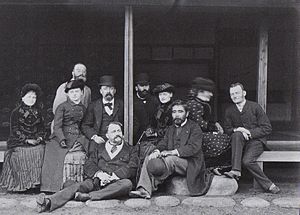
In 1871, Beato was the official photographer for the United States naval expedition to Korea. Beato's photos are the earliest clear pictures of Korea that we know of.
In 1877, Beato sold most of his photo collection to a company called Stillfried & Andersen. They moved into his studio. Stillfried & Andersen then sold the collection to Adolfo Farsari in 1885. After selling his photos, Beato seemed to stop photography for a few years. He focused on being a financial trader. On November 29, 1884, he left Japan and ended up in Port Said, Egypt. A Japanese newspaper reported that he had lost all his money.
Photography in Burma
From 1884 to 1885, Beato was chosen as the official photographer for the Nile Expedition. This was a British military trip to Khartoum, Sudan. Beato arrived in April 1885, but he had missed the main mission by three months. So, he photographed the British troops leaving the area.
He arrived in Burma probably in December 1886. This was after Upper Burma had been taken over by the British in late 1885. The British newspapers had written a lot about the three Anglo-Burmese Wars. Beato, who had photographed military actions in India and China, was likely interested in this news. Even though he arrived after the main fighting, he still saw action. The British takeover led to a rebellion that lasted for ten years. This allowed Beato to take many pictures of the British military and also of rebel soldiers and prisoners.
Beato set up a photo studio in Mandalay, Burma. In 1894, he also opened a shop selling interesting old items and antiques. He ran both businesses separately and they were very successful.
Because of his past experience and fame from his time in Japan, many wealthy local people came to him. They posed in traditional clothes for official portraits. He also sold other photos, like Buddhas, landscapes, and buildings, from his main albums in Burma and Europe.
By that time, Beato's photos had become the main way the rest of the world saw Burma. This lasted for decades. In his old age, Beato became an important businessman in Colonial Burma. He was involved in many different businesses, from electric works to life insurance and mining.
Death and Lasting Impact
For a long time, people thought Beato died in Rangoon or Mandalay in 1905 or 1906. But his death certificate, found in 2009, shows that he died on January 29, 1909, in Florence, Italy.
How Beato Took His Photos
Photos from the 1800s often show the limits of the technology back then. But Beato managed to work very well within these limits. He mostly made albumen silver prints. These were made from wet collodion glass-plate negatives.
Beato was a pioneer in two special techniques: hand-colouring photos and making panoramas. He might have started hand-colouring photos after a suggestion from Wirgman. Or he might have seen hand-coloured photos by other photographers. Whatever the reason, Beato's colored landscapes look very natural. His colored portraits are more brightly colored and are considered excellent.
Besides adding color, Beato also found a way to show very large scenes. He did this by taking several photos next to each other. Then he would join the printed photos together very carefully. This created a wide, sweeping view. For example, his panorama of Pehtang is made of seven photos joined together. It is more than 2 meters (6 1/2 feet) long!
Images for kids
See also


